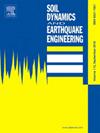可液化土壤中轴向加载桩数值分析的启示
IF 4.2
2区 工程技术
Q1 ENGINEERING, GEOLOGICAL
引用次数: 0
摘要
在可液化土壤中的轴向加载桩可能会因地震事件而发生严重沉降。震动期间,桩周围产生的过大孔隙压力 (ue)会导致桩轴和桩尖承载力下降,从而引起沉降。震后,桩周围的液化土重新固结产生的土壤沉降会产生额外的荷载(称为拖拽荷载),导致桩的下拖沉降。估算轴向荷载分布和桩身沉降对于设计和评估液化土中轴向荷载桩的性能至关重要。在实践中,采用的是简化的中性面求解法,将液化土作为固结层建模,而不考虑ue 产生/溶解的影响。TzQzLiq 分析法通过考虑过剩孔隙压力(ue)的产生/消散对轴和桩尖承载力的影响,对液化土中轴向加载桩的荷载和沉降响应进行建模。本文通过将简化中性面法与经超重力模型试验验证的 TzQzLiq 分析法进行比较,指出了简化中性面法在预测阻力荷载和下拖沉降方面存在的不足。结果表明,中性平面法预测的阻力荷载和下挠沉降可能被高估或低估,这取决于桩的荷载、矢量消散率和土壤沉降。在所研究的案例中,我们发现大部分的桩沉降都发生在震动期间,这是由于周围土壤中ue的发展导致桩尖阻力减小。虽然在重新固结过程中会产生较大的阻力荷载,但由此产生的下拖沉降很小。虽然中性面方法预测的下拽沉降一般与 TzQzLiq 分析结果相当,但它对阻力荷载的预测过高,无法预测同震沉降。最后,该研究提倡开发和使用基于位移的程序(考虑地震事件期间和之后发生的所有机制),如基于 TzQzLiq 分析的程序,以准确评估桩的性能(即桩的沉降和最大荷载),从而提供全面安全、高效和优化的设计。本文章由计算机程序翻译,如有差异,请以英文原文为准。
Insights from the numerical analysis of axially loaded piles in liquefiable soils
Axially loaded piles in liquefiable soils can undergo severe settlement due to an earthquake event. During shaking, the settlement is caused by the decreased shaft and tip capacity from excess pore pressures (ue) generated around the pile. Post shaking, soil settlement from the reconsolidation of liquefied soil surrounding the pile results in the development of additional load (known as drag load), causing downdrag settlement of the pile. Estimating the axial load distribution and pile settlement is essential for designing and evaluating the performance of axially loaded piles in liquefiable soils. In practice, a simplified neutral plane solution method is used, where the liquefied soils are modeled as a consolidating layer without considering the effect of ue generation/dissipation. A TzQzLiq analysis models the load and settlement response of axially loaded piles in liquefiable soils by accounting for the effect of excess pore pressure (ue) generation/dissipation on the shaft and tip capacity. This paper presents the deficiencies of the simplified neutral plane method in predicting the drag load as well as the downdrag settlement by comparing it with the TzQzLiq analysis validated with hypergravity model tests. The results show that the drag load and the downdrag settlement predicted by the neutral plane method might be over- or under-estimated depending on the pile load, the rate of ue dissipation, and the soil settlement. For the cases studied, it was found that most of the pile settlement occurs during shaking due to the decrease in the pile's tip resistance from the development of ue in the soil surrounding it. While large drag loads develop during reconsolidation, the resulting downdrag settlement is small. While the neutral plane method generally predicted a downdrag settlement comparable to that of the TzQzLiq analysis, it overpredicted drag load and could not predict co-seismic settlement. Finally, the study advocates for the development and use of a displacement-based procedure (accounting for all the mechanisms occurring during and after an earthquake event) such as based on TzQzLiq analysis in accurately evaluating the performance of the pile (i.e., the pile settlement and the maximum load), thus providing an overall safe, efficient, and optimized design.
求助全文
通过发布文献求助,成功后即可免费获取论文全文。
去求助
来源期刊

Soil Dynamics and Earthquake Engineering
工程技术-地球科学综合
CiteScore
7.50
自引率
15.00%
发文量
446
审稿时长
8 months
期刊介绍:
The journal aims to encourage and enhance the role of mechanics and other disciplines as they relate to earthquake engineering by providing opportunities for the publication of the work of applied mathematicians, engineers and other applied scientists involved in solving problems closely related to the field of earthquake engineering and geotechnical earthquake engineering.
Emphasis is placed on new concepts and techniques, but case histories will also be published if they enhance the presentation and understanding of new technical concepts.
 求助内容:
求助内容: 应助结果提醒方式:
应助结果提醒方式:


